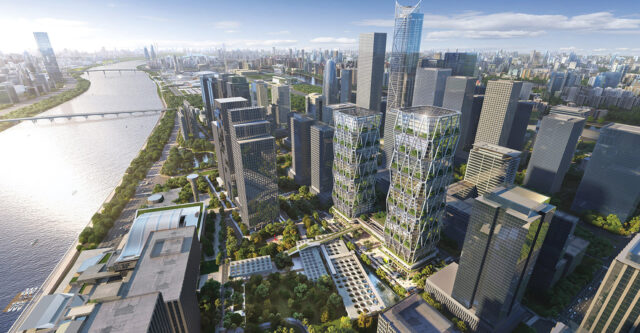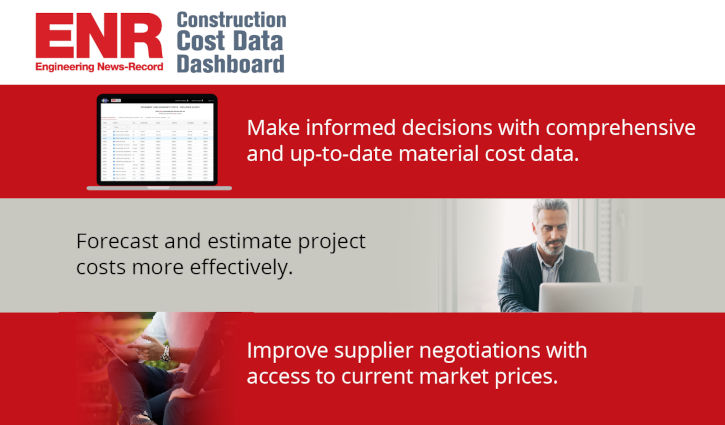ENR 2024 Top Design Firms Sourcebook: Artificial Intelligence Ramps Up
July 16, 2024
ENR 2024 Top Design Firms Sourcebook: Artificial Intelligence Ramps Up
July 16, 2024Skidmore, Owings and Merrill (SOM) is designer on the Sany IROOTECH headquarters in Guangzhou, China. Floors are suspended from the external diagrid structure, eliminating the need for internal columns, the firm says. The diagrid design also shows better performance during seismic events, it adds.
Rendering courtesy of SOM
Related Link:
ENR 2024 Top 500 Sourcebook (PDF)
(Subscription Required)
Commentary from the Top 500 Design Firms in 2024 reveals a shift in the use of artificial intelligence to complement design services. Last year, AI was the exception more than the rule, but this year more design professionals aim to integrate tech into operations. With ongoing labor challenges, inflation and supply chain disruptions still driving up construction costs, firms say AI could be the X factor that helps projects stay profitable.
“AI has the potential to not only improve the efficiency of our teams and the quality of our projects but also help address staff shortages,” says Andy Platz, CEO and chair of Mead & Hunt. “By delegating tasks to AI, from communication to the design process, its tools offer both promise and risk, and as such they must be managed by licensed professionals to ensure the quality of the work performed.”
AO Managing Partner RC Alley says the firm has been actively experimenting with ways to integrate artificial intelligence into its practice as it begins to take off in the AEC sector.
“We firmly believe that AI is not just a passing trend but a permanent fixture in our industry,” he says. “We have found that AI serves as a powerful tool for design ideation and research. During the conceptual phase, it enables our designers to explore multiple alternatives and visualize possibilities, significantly augmenting our creative vision.”
Additionally, Alley points out that the company has leveraged artificial intelligence tools for zoning and research validation, enabling it to quickly explore alternative paths that have marginal impacts on employee workload.
“While we embrace benefits that AI brings to our practice, we remain grounded in the understanding that these can never fully replace our accumulated real-world expertise,” he says. “Our commitment to blending cutting-edge technology with human insight ensures we deliver the best possible outcomes for clients and communities.”
Like the industry’s adoption of Revit and BIM technologies, AI is primed to transform the design process in an even faster time frame, explains HMC Architects President and CEO Brian Staton.
“Going into the future, technology is going to continue to change this profession with BIM and artificial intelligence,” he says.
Beyond AI, Top 500 firms say they are exploring full digital integration at their companies to improve efficiency and reduce labor waste.
Arup says it is close to achieving “true digital and physical integration” with the help of digital twins employing AI algorithms.
At GZA, President and CEO Patrick Sheehan says a mix of virtual reality, digital twins and telemetry is helping the firm deliver near real-time information and decisionmaking to clients.
Mixed reality and digital engineering take that process one step further at GHD. President Kumar Parakala says the technology enables the firm to harness the best of virtual and physical domains.
“Liberated from geographical barriers, projects are visualized in a visually rich, interactive space that allows technical and non-technical users and audiences to better understand project complexities—and this is only one of many possibilities,” says Parakala.
Overall, technology integration adds to a firm’s flexibility, says HMC Architects Chief Technology Officer Bill Kwon.
“As we have all experienced during and post-pandemic, being digitally nimble in collaboration has made us even more effective in sharing ideas, collective design activity, and faster validation,” he says.
According to Scott Crawford, principal and landscape architect at RDG Planning and Design, the use of AI and more digital tools are advancing design to be a fully visual process.
“The faster we make it immersive, the easier it is to generate consensus on ideas and alignment around inspired design,” Crawford says. “This allows our team to quickly curate viable solutions as a baseline for exploration—saving hundreds of hours in design.”
The Articles
General Building
$5B Medical Campus Set to Rise in Dallas
McCarthy-Vaughn joint venture will serve as construction manager

Children’s Health and UT Southwestern Medical Center has selected a team of HKS and Perkins&Will to design a $5-billion pediatric health campus in Dallas.
Transportation
Columbus Airport Plans Sleek New Terminal
Estimated $2-billion program emphasizes sustainability and technology

Opened at the dawn of the Space Age, the 66-year-old terminal at John Glenn Columbus International Airport in Columbus, Ohio will soon give way to a new facility that embodies the aspirations for air travel in the 21st century.
Oil and Gas
Plant Tests Ocean Carbon Dioxide Removal
Arup begins feasibility study of commercial-scale facility set for Canada site

Engineering has begun on a project its developers say could mark a new foray into ocean-based carbon dioxide removal.
Power
Norway Solar Component Maker Lands in US
Ingot and wafer manufacturer NorSun will build $620M plant in Tulsa, Okla.

Norway-based solar energy component manufacturer NorSun says it plans to spend $620 million to build its first U.S.-based factory—a 5-GW facility in Tulsa, Okla., that will produce silicon ingots and wafers for solar cells and panels, the firm announced.
Environmental
Harbor Island Redevelopment Plans Progress
A new public-minded vision for a former industrial site in Michigan

HDR recently introduced three redevelopment concepts for Harbor Island off Grand Haven, Mich., which will offer recreational activities on the former industrial site.
Manufacturing
Expanding Pharmaceutical Production
Novo Nordisk plans $4.1-billion North Carolina plant with BE&K Building

Novo Nordisk, the Denmark-based health care company, is planning to invest $4.1 billion to expand its U.S. manufacturing capacity with a second fill and finishing facility in Clayton, N.C.









